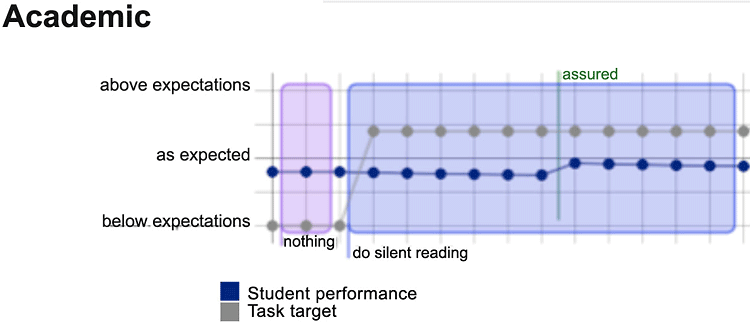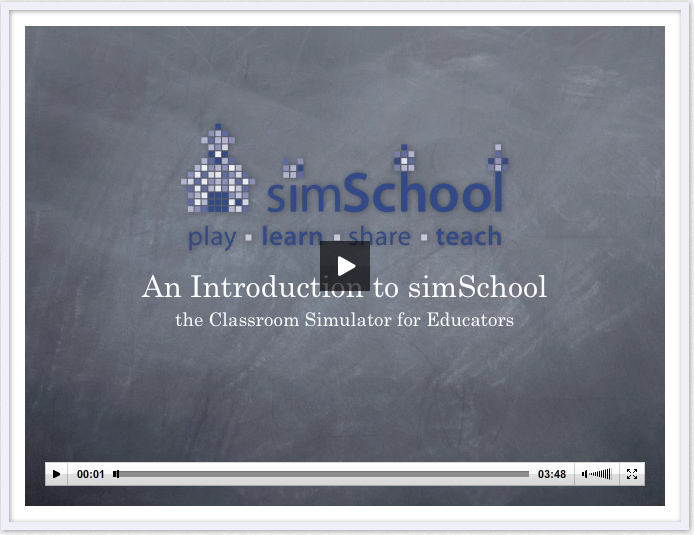Key Takeaways
- Can someone learn to teach by practicing with a classroom simulation?
- Simulations provide multiple chances to practice, including making attempts with higher risks and spectacular failures, and to learn, retry, and master new skills faster and with less effort than through experiences not mediated by computers.
- Simulations can also be shown to help stimulate the development of heuristic skills in teachers.
- The goal of advancing technologies of everyday life in education can be realized through creative application of education simulators.
In other countries teachers earn as much as beginning doctors do in the United States, and they are often mentored by other teachers for as many as 15 hours a week.1 This throws into sharp contrast the gaps, lack of technological vision, and deprofessionalized status of teachers in America — points articulated earlier this year by world educational leaders at the first International Summit on the Teaching Profession in New York City.2 To address these problems, the National Education Technology Plan (NETP) of 2010 proposed concrete ways of realizing a needed paradigm shift — implementing a new approach to U.S. teacher education that is innovatively online, scalable, personalized, data-rich, well-suited to the gamer-teacher generation, and adaptable to varying levels of expertise.
Online learning environments have been said to be facing a “perfect e-storm” linking pedagogy, technology, and learner needs.3 This article aims to answer the question “Can someone learn to teach by practicing with a classroom simulation?” We believe the answer is an emphatic “Yes.” A strong indicator is the award of an EDUCAUSE Wave 1 Next Generation Learning Challenges program grant, which supports an alternative idea for the preparation of teachers and the improvement of teaching — a “flight simulator” for teachers in the form of a simulated classroom game called simSchool.
The simSchool project addresses key systemic challenges of teacher education including:
- Fundamental conceptions of teaching and learning
- Organization of knowledge, assessment practices, and results
- Engagement of a global community of practice in teacher education
It offers a new paradigm for teacher education based on self-direction and personal validation in a complex yet repeatable practice environment. It is supported by emerging interdisciplinary knowledge concerning the unique affordances of digital media assessment and social media. Here, we briefly review the rationale and approach taken by simSchool.
Background and Development of simSchool
The simSchool platform was established in 2003 with a grant from the Preparing Teachers to Teach with Technology program of the U.S. Department of Education. The model of teaching and learning embodied in the simulator is a synthesis model using theories from psychology, cognitive science, learning theory, complex systems, and instructional design. Technically, the artificial intelligence model uses a hill-climbing algorithm to mimic how learners adjust and adapt themselves to meet the physical, emotional, and cognitive requirements of a task. The adjustment process takes place in a multidimensional space for each virtual student and evolves during each class session depending on what you, the player, do as a teacher.
When you launch a simSchool session, you see a classroom setting with students sitting in rows of individual desks. Each student has a unique personality and learns in a unique way, and is either drawn randomly from over 2 million students or is a custom student you or someone else has created to represent a particular teaching challenge. You, as the teacher of the class, can review your class’s student records or start the class session. Once the class has started, you can select tasks for students to work on, monitor how learning is progressing, decide whether to talk or not, whether to change the task, and when to end the class. As time moves forward, the students progress on their own individual learning trajectories, whether you take action or not. So if you do nothing, they may get bored (or be happy because they need that time to keep working on the task); if you choose a task that is too hard for them, they will slump in their seats and say things that give you clues about their difficulties. Students might raise their hands if they need help or want to say something. Your performance is documented and gives you a detailed, moment-by-moment analysis of your decisions and their impacts.
The platform allows you to create a wide variety of classroom environments (sims) by (1) defining parameters of race, gender, and academic ability; (2) choosing which students you want to work with; and (3) identifying the goals for the classroom set-up. Then, you and others can launch and play with the sim, investigate your results, evaluate and consider your strategies, and play again!
The advantages of the virtual environment for practicing a wide variety of teaching skills include:
- Low stakes — no child is harmed by your experiments
- Ability to work with a wide diversity of virtual students, including special needs populations
- Flexibility to play, experiment, create, and explore different strategies
- Freedom from financial, time, and administrative constraints of physical classrooms and field work; this is "virtual" field work with real educational benefit
- Scalable and conducive to a distributed student user population
- Development of a community, through crowd-sourced knowledge, shared content creation, and forums that promote dialogue and mentorship
The infrastructure of simSchool relies on a conception of teaching as a socially constructed field of knowledge. For this reason, the website hosts a social hub of users, some of whom are learning about the theories, others who are using the simulation in classes, and those who are authors of new challenges. Still others are conducting research and writing reflective articles on the challenges, opportunities, and limitations of learning to teach with a simulator like simSchool.
Heuristic Knowledge and simSchool
What makes game and simulation-based learning so powerful?
When the concept of creating a simulation to train teachers was first introduced, an early challenge was convincing people that the complex needs of teaching and learning could be adequately met in this environment. We briefly review that argument again here to provide assurance that these considerations have been addressed. In addition, since its launch in 2003, we have discovered that learning in a simulator like simSchool is a powerful alternative to other modalities.
It was important to identify some of the affordances and limitations of all simulation models in order to show that a classroom simulation could be sophisticated and complex enough to educate teachers and stretch their imaginations. Consider an elementary school teacher giving an earth sciences lesson. As a constructivist and inquiry-oriented teacher, she gives the students a single light bulb in a stand to represent a light source (the sun) along with a basketball (the earth) and softball (the moon). She dims the lights and challenges the students to experiment with these objects until they find a way to show the phases of the moon. Even though the relative positions, sizes and shapes of the balls, the light source, and the room do not directly represent reality, the students gain important insights into some of the dynamics, geomechanics, and perspectives of the observable relationship between the earth and moon.
This vignette illustrates how even a simple model of reality can benefit learning. For example, it shears away unnecessary details while simplifying a real system. Models allow us to hold — in our hands and minds — some aspects of a system that cannot otherwise be experienced.4 Other benefits include:
- Increased safety — a pilot in training can crash a virtual plane without causing real damage.
- Decreased costs — virtual materials can be more easily built, modified, and shared.
- Enhanced focus on the relationships — the simplified features make a theory into an operational model amenable to manipulation.
Simulations also provide multiple chances to practice (including higher risk attempts that could cause spectacular failures) and to learn, retry, and master new skills more rapidly and with less effort than through experiences not mediated by computers. In teacher preparation, simulations that provide targeted feedback can develop teachers’ understanding and practice, and may be as effective as in-classroom field experience.5
Limitations of simulation models include the fact that they cannot fully replicate real experience and, as simplifications, risk omitting something vital. And, yet, recent policy recommendations for teacher professional development support the use of simulation models as promising new tools.6 This approach emphasizes an important underlying principle of simSchool: practice in a variety of settings builds expertise. Indeed, virtual settings may be as effective as real ones if the models are robust and comprehensive enough.
How does simSchool work, and what has research shown are its main effects?
People who practice with a simulator develop a deeper heuristic understanding because of their reliance on — and experience of — immersive multimedia. This practice taps deeply into physical, emotional, and cognitive pathways.7 Initial evidence indicates the extent to which heuristics are enhanced; for example, one study of pre-service teachers found that while they could not articulate what they had learned, as a result of exposure to simSchool they outscored non-players in their teaching skills.
The example of the simulated student “Thomas” (Figure 1; based on a real student) effectively illustrates how heuristic knowledge can develop — even without the user’s metacognitive awareness. The scenario demonstrates the dynamic and interactive nature of the simSchool experimental framework variables and the extent to which they influence heuristic methods of teaching.

Figure 1.Thomas, 7th Grade
Thomas is a simulated seventh grader who has a severe, post-lingual hearing loss. His hearing loss impacts his oral and written language skills and makes it difficult for him to work independently and integrate socially. A user playing the role of Thomas’s teacher in simSchool has two choices to make while teaching him: which tasks should Thomas do now, and what should the teacher say to him?
Observable Variables: Thomas’s education profile describes him as both functioning below grade level academically and having low self-esteem and difficulty respecting boundaries and classroom expectations. These characteristics imply that certain kinds of tasks and certain verbal approaches are likely to work better than others. The user learns about Thomas by reading his school file, and by through working with him in class over time, she/he comes to see the impacts of task choice and verbal interactions with Thomas called “talking attempts” or “teacher talk.”
Hidden Variables: These refer to Thomas’s cognitive ability, emotional stability, other personality dimensions, and slower learning pace. Such variables affect all of his interactions in response to tasks and teacher talk. As the user attempts to teach Thomas, these variables directly affect his classroom behavior, his body position, the way he speaks to the teacher and his academic performance.
Independent Variables: Teacher decisions can be thought of as independent variables in an ongoing experiment in their own classrooms that builds expertise over time.8 A user selects a task such as “do silent reading” that interacts with Thomas’s observable and hidden variables. For instance, when the user speaks to him (about 30 seconds after the task is assigned), it is clear that both observable and hidden variables are impacted.
Dependent Variables: The impact of a teacher’s decisions — such as assigning silent reading — is presented as a simple visual graph for reflection and discussion. Figure 1 shows that while Thomas’s academic performance is below that required for “silent reading,” it improved when the teacher made a supportive observation.

Figure 2. Task Assignment and Impact
This example, which represents about one minute of real time and simulates about seven minutes of class time, provides an opportunity to discuss the development of teaching habits. Note that when “nothing” is the task, there is no change in the learner and no chance of acquiring any academic content. But, given certain academic requirements, Thomas begins to respond.
What are the possible heuristic lessons from this task choice? At the beginning, the requirement of the task was academically too high for this learner, resulting in a slight deterioration in academic performance. The user might rationalize this in terms of the difficulty of the task, the timing of introducing this task, or an absence of effective preparatory tasks or verbal cues — all are equally true.
When later in the simulation the user speaks with Thomas, it becomes clear that interaction improves his academic prospects. However, because the distance to the task requirement is still too great, a slight academic deterioration again occurs. Nonetheless, there is a cumulative improvement, in spite of the initial setback. What are the possibilities here for learning new teaching heuristics? That teacher talk imparted critical — but initially insufficient — information, and that the teacher would probably have succeeded in improving Thomas’s chances of achieving this task over time? During this verbal interaction, what were other students in the class doing? The point here is that teaching is complex, layered, and multi-causal; actual user performance and detailed documentation in a simulation provide a window into these subtleties.
While there are no completely “right” answers, there are hosts of partially right ones. This facet of simulation supports its role in developing teachers’ heuristic skills. Instead of verbalized “stock answers,” the teacher learns a set of estimations, educated guesses, and rules of thumb for similar situations. A user can run simulations repeatedly to try out alternatives and build up a history of interaction-based knowledge. In the case of Thomas, does talking sooner help more? Would Thomas succeed at a different task? Of the available tasks, which one would be the best “first” task for him? What ways of speaking to Thomas would have the best effect during this particular task? Some combinations of question-and-answer clearly work better than others and overlap in complex ways, building up a heuristic pedagogical base.
Conclusions
A simSchool user becomes a part of an engine of experimentation, as summarized in this audio file (1:42 minutes):
When using a simulation platform such as simSchool to prepare teachers for teaching in the 21st century, the fundamental conceptions of teaching and learning, the organization of knowledge, assessment practices and results, and the engagement of communities of practice must be radically reconfigured from typical online courses and single-experience e-learning experiences to a new world of game-like social network experiences. In dramatic contrast with traditional course-based online learning experiences, the new paradigm focuses on the development of heuristic knowledge that has been self-guided and personally validated in complex but repeatable environments. Readers are encouraged to join the research and explore by going to www.simschool.org.
Acknowledgments
The authors would like to thank the Next Generation Learning Challenges program and its funding partners, as well as Nancy Millichap and Carie Page for their encouragement, expertise, and advice.
- Linda Darling-Hammond, “U.S. vs Highest-Achieving Nations in Education,” The Washington Post (March 23, 2011).
- Vivien Stewart, “Improving Teacher Quality Around the World,”Phi Delta Kappan, Vol. 92, No. 8 (2011), pp. 93–94.
- Curtis J. Bonk, The Perfect e-Storm: Emerging Technologies, Enhanced Pedagogy, Enormous Learner Demand, and Erased Budgets (London: The Observatory on Borderless Higher Education, 2004).
- John Holland, Hidden Order: How Adaptation Builds Complexity (Reading, MA: Perseus Books, 1995).
- Rhonda Christensen, Tandra Tyler-Wood, Gerald Knezek, and David Gibson, “SimSchool: An Online Dynamic Simulator for Enhancing Teacher Preparation,” International Journal of Learning Technology, Vol. 6, No. 2 (2011), pp. 201–220.
- Pam Grossman, “Learning to Practice: The Design of Clinical Experience in Teacher Preparation,” Partnership for Teacher Quality (May 2010).
- David Gibson, “Modeling Classroom Behaviors in Software Agents,” in Digital Simulations for Improving Education: Learning Through Artificial Teaching Environments, David Gibson and Young Baek, eds. (Hershey, PA: IGI Global, 2009).
- Gerald Girod, Mark Girod, and Jeff Denton, “Lessons Learned Modeling ‘Connecting Teaching and Learning’,” in Games and Simulations in Online Learning: Research and Development Frameworks David Gibson, Clark Aldrich, and Marc Prensky, eds. (Hershey, PA: IGI Global, September 2007), pp. 206–222.
© 2011 David Gibson and Stacy Kruse. The text of this article is licensed under the Creative Commons Attribution-Share Alike 3.0 license.


